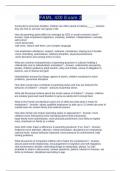FAML 430 Exam 2
Among Euro-American facilities, children are often raised to believe_____ - Answer-
they are free to set their own goals in life
How do parenting styles differ (on average) by SES or social economic class? -
Answer- High-emphasize happiness, creativity, ambition, independence, curiosity,
self-control
-more democratic
-talk more, reason with them, use complex language
Low-emphasize obedience, respect, neatness, cleanliness, staying out of trouble
-more controlling, authoritarian, arbitrary discipline, physical punishment
-short directives and varying tones of voice
What are common characteristics of parenting practices in cultures holding a
collectivistic and or individualistic orientation? - Answer- collectivistic-amused by
people, children guided by adult wisdom, obey and imitate, sense of obligation to
parents, use of shame and guilt
individualistic-amused by things, agents of action, children socialized to solve
problems, preventive discipline
How does social class contribute to parenting styles and how we interpret the
behavior of children? - Answer- -amount of parental stress
What did Rousseau believe about the innate nature of children? - Answer- children
are innately good and need freedom to grow so adults don't corrupt them
What is the Family and Medical Leave Act of 1993 and what does it mean for
employees? - Answer- allows qualified employees to take up to 12 weeks per year of
unpaid leave for certain family and medical reasons
How does family size impact parenting styles or approaches? - Answer- more
children=more interactions=less individual parent-child interactions
large family-more authoritarian, more physical punishment, less likely to explain
rules, emphasis on family as a whole
Does birth order make a difference in parenting practices? If so, how? - Answer-
firstborns-more attention, affection, verbal stimulation, disciplined ore restrictively,
coerced more, mature behavior expected, more pressure for achievement, help
solving problems
What do parents of competent children do to foster the competence? - Answer-
secure parent-child relationship, encouragement of cognition and self-regulation,
safe environment, flexible, interesting things to manipulate, always "on call",
available to share in discoveries, answer questions, patient, tolerant of messes, set
limits on behavior, disciplined according to age
, What are characteristics of abusive families? - Answer- domestic violence, parents
abused as children, emotional problems, financial problems, lack knowledge of child
development, alcoholism, emotionally immature, lack behavior management
What factors contribute to social economic status? - Answer- income, occupation,
education of parents
In which ecological systems would parental occupation fall? - Answer- exosystem
What are the most significant predictors of quality child care? - Answer- size of
overall group, caregiver-child ratio, specialized training
What does developmentally appropriate mean? What are characteristics of DAP? -
Answer- knowledge of normal growth patterns and individual differences
How have custodial arrangements for children changed over time? - Answer-
Custody arrangements were intended to reward the innocent party and punish the
guilty one (child support), now "no-fault" divorce divides things equally so no one is
intentionally rewarded or punished
What is the different between an "independence" and "interdependence" cultural
framework for socialization of children and a caregiving setting? - Answer-
What did Rene Spitz find out about children who were raised by the mothers in
prison? - Answer- infants raised in prison developed normally because of one-on-
one care
How might the amount of time children spend in child care contribute to their
development? - Answer- greater risk of insecure attachment, risk of emotional and
behavioral problems in later childhood
According to some research, what differences exist between children who attend a
quality child care program and those who don't? - Answer-
What are the milestones at each stage in Piaget's theory of cognitive development? -
Answer- sensorimotor-thinking is action
preoperational-thinking is based on appearances
concrete operational-thinking is based on reality
formal operational-thinking is based on abstractions
What is the difference between cultural assimilation, a melting pot, and cultural
pluralism? - Answer- assimilation-minority group takes on characteristics of majority
melting pot-diverse groups blend into a common culture
pluralism-mutual appreciation and understanding of various cultures and coexistence
in society
What conditions increase the risk of child maltreatment? - Answer- history of
maltreatment, behaviors such as crying, hyperactivity, inability to give an acceptable
response, disabilities




